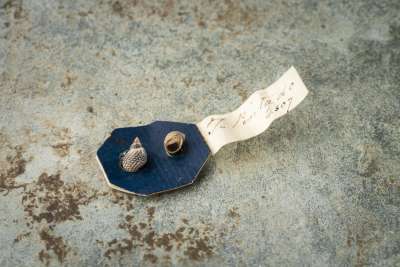White-spot periwinkle
Shells from George Montagu’s collection.
This species is not included in any of Montagu’s publications and it is puzzling, as it was not described until 1828 by Wood. The mount and label are typical of all of the Montagu mounts in Exeter. This is the only original label in the Montagu collection that bears a species name erected after the death of Montagu (Turbo pintado). There are a number of unpublished names on similar labels and one can only surmise that this is a manuscript name adopted at a later date by Wood.
These shells have the operculum in place suggesting they were collected alive, which is unlike the majority of the exotic shells in the collection as most are worn and have some degree of incrustation upon them. It is noteworthy that the specimens of Echinolittorina ziczac (Gmelin, 1791) in the Montagu collections also have the operculum in place and appear live collected.
In January 2020 the Montagu Collection was awarded Designated status by Arts Council England. This mark of distinction recognises the collection’s international significance to the scientific community - it is the most intact and taxonomically important collection of British shells of the early 19th century (1800-1816) to be found anywhere in the UK.
This species is not included in any of Montagu’s publications and it is puzzling, as it was not described until 1828 by Wood. The mount and label are typical of all of the Montagu mounts in Exeter. This is the only original label in the Montagu collection that bears a species name erected after the death of Montagu (Turbo pintado). There are a number of unpublished names on similar labels and one can only surmise that this is a manuscript name adopted at a later date by Wood.
These shells have the operculum in place suggesting they were collected alive, which is unlike the majority of the exotic shells in the collection as most are worn and have some degree of incrustation upon them. It is noteworthy that the specimens of Echinolittorina ziczac (Gmelin, 1791) in the Montagu collections also have the operculum in place and appear live collected.
In January 2020 the Montagu Collection was awarded Designated status by Arts Council England. This mark of distinction recognises the collection’s international significance to the scientific community - it is the most intact and taxonomically important collection of British shells of the early 19th century (1800-1816) to be found anywhere in the UK.
Object Summary
- Accession Loan No.
- Moll4307
- Collection Class
- Molluscs
- Collection Area Region
- Caribbean
- Collector Excavator
- Montagu, Colonel George (from the collection of)
- Common Name
- white-spot periwinkle
- Simple Name
- mollusc: shell
- Period Classification
- George III (1760-1811)


